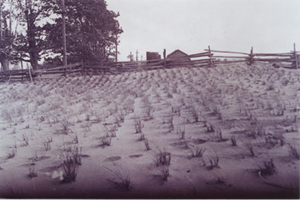 Lots of attention has been directed to California's food producing problems - with good reason since the entire state is under a drought. However, modern day water problems are not just in California. Google "Kansas Dust Storm" and you'll see shocking footage of a modern day dust-bowl type storm that happened this spring 4-28-2014. These weather events combined with the pending loss in reserve currency status (that would make food imports very expensive) may soon not only affect U.S. food prices but overall food availability.
Lots of attention has been directed to California's food producing problems - with good reason since the entire state is under a drought. However, modern day water problems are not just in California. Google "Kansas Dust Storm" and you'll see shocking footage of a modern day dust-bowl type storm that happened this spring 4-28-2014. These weather events combined with the pending loss in reserve currency status (that would make food imports very expensive) may soon not only affect U.S. food prices but overall food availability. Those that forget their history are doomed to repeat it.
 Most people would think this photo came from somewhere in Kansas during the Dustbowl period in the 1930's. They would be wrong. A combination of drought and misuse of marginal farmland led to Dust Bowl-like conditions in New York beginning in the 1920s.
Most people would think this photo came from somewhere in Kansas during the Dustbowl period in the 1930's. They would be wrong. A combination of drought and misuse of marginal farmland led to Dust Bowl-like conditions in New York beginning in the 1920s.Before the middle of the 19th century, forests had been primarily viewed as inexhaustible and an obstacle to civilization; they were something to be cleared out of the way for agriculture, or to be cut and exploited for profit. By the 1880s, less than 25% of New York State was forested, and the remaining uncut forests in the Catskills and Adirondacks were being logged fast. In 1885, New York created the Forest Preserve Act to protect state owned lands in the Catskills and Adirondacks from further exploitation. This act was strengthened in 1894 by an amendment to the New York State Constitution:
"The lands of the state, now owned or hereafter
acquired, constituting the forest preserve as now fixed by law, shall be
forever kept as wild forest lands. They shall not be leased, sold or
exchanged, or be taken by any corporation, public or private, nor shall
the timber thereon be sold, removed or destroyed."
Since back yards aren't available for everyone, other sources of food might be produced from basement or closet based hydroponic type systems. One body of technology that may offer some promising solutions is the illegal pot growing industry. Many "kits" needed to grow marijuana plans indoors can be easily adopted to growing other crops such as tomatoes. Ironically, the patent laws might soon make growing any plant from seed be something that is just as much a criminal offense as growing pot from seed now is. Given the potential for profitable shakedowns for those who dare save seeds, the ability to grow plants covertly may eventually be of some benefit.